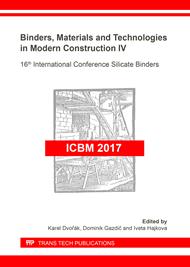p.103
p.110
p.116
p.122
p.128
p.134
p.140
p.148
p.154
Nonlinear Acoustic Spectroscopy Method for Nondestructive Testing of Thermally Damaged Concrete
Abstract:
Most concrete structures are subjected to a range of temperature corresponding to normal environmental temperatures. However, there are important cases where concrete structures may be exposed to much higher temperatures (e.g., jet aircraft engine blasts, building fires, chemical and metallurgical industrial applications in which the concrete is in close proximity to furnaces, and some nuclear power-related postulated accident conditions). Exposure of concrete to high temperatures affects its mechanical properties. In this paper we examine the dependence of the fundamental frequency on temperature to which the concrete beams were heated. Fundamental frequencies were obtained by an innovative method used Pseudorandom Binary Sequence of Maximum Length as a perturbation signal. For the verification of the results the Ultrasonic Pulse Velocity in concrete were also measured and flexural bending strengths were determined. The results show method with Pseudorandom Binary Sequence of Maximum Length as a perturbation signal as a very promising for non-destructive testing of thermally damaged concrete.
Info:
Periodical:
Pages:
128-133
Citation:
Online since:
June 2018
Authors:
Price:
Сopyright:
© 2018 Trans Tech Publications Ltd. All Rights Reserved
Share:
Citation:


